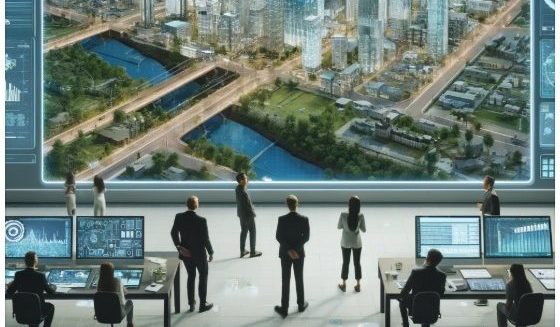Overview
Digital twin technology is revolutionizing industries by creating virtual replicas of physical systems or assets that provide real-time insights, predictive analytics and optimization opportunities. Governments at every level are beginning to harness this transformative technology to improve infrastructure, urban planning and citizen engagement.

Cities like Singapore have been trailblazers with their Virtual Singapore initiative, which offers a dynamic 3D model of the city. This tool enables policymakers to simulate traffic patterns, assess energy usage, and prepare for disaster scenarios. Closer to home, Orlando, Florida, is leveraging digital twins to optimize energy efficiency and water management, showing that this technology has practical applications for U.S. cities and municipalities.
Innovation Momentum
As of now, precise data on the exact number of U.S. localities that have implemented digital twin technology is limited. However, several cities have publicly announced or initiated digital twin projects to enhance urban planning, infrastructure management and sustainability efforts.
Notable examples include:
- Carson City, Nevada has implemented a digital twin of its water system to address water shortages and improve resource management.
- Chattanooga, Tennessee is using digital twin technology to model and alleviate traffic congestion. The digital twin uses information from 500 different sources, including traffic cameras, 911 data, radar detectors and weather stations.
- Las Vegas, Nevada is developing a digital twin of its downtown area to optimize energy use and support sustainability initiatives.
- New York City has committed to building virtual models of its downtown districts to develop strategies aimed at reducing carbon emissions and improving energy efficiency. Additionally, other recent projects use real-time traffic data to model intermodal traffic systems, including (1) SUMO: Simulation of Urban Mobility, which models road vehicles, public transport, and pedestrians; (2) CARLA: Car Learning to Act, which supports development, training, and validation of autonomous driving systems; and (3) COSMOS: A “beyond-5G” test bed that collects real-time traffic data
- Phoenix, Arizona has also committed to creating a digital twin of its downtown district to enhance urban planning and reduce environmental impact.
While these examples highlight the growing interest in digital twin technology among U.S. cities, comprehensive data on nationwide adoption is not readily available. Analyst predictions suggest that over 500 urban digital twins are expected to be deployed globally into 2025 and beyond, with significant growth anticipated in the near term.
It’s important to note that the adoption of digital twin technology varies widely based on factors such as city size, budget constraints and specific urban challenges. As the technology becomes more accessible and its benefits more evident, it’s likely that an increasing number of U.S. localities will explore and implement digital twin solutions to enhance urban management and planning.
Applications in Government
Digital twins provide wide-ranging benefits for the public sector:
- Urban Planning and Sustainability: By simulating urban developments, governments can predict the environmental impact of projects, optimize resource use, and reduce waste.
- Infrastructure Management: Predictive maintenance powered by digital twins minimizes downtime for critical infrastructure like bridges, roads, and public transit systems.
- Disaster Recovery/Emergency Preparedness: Real-time disaster modeling helps agencies refine response strategies, saving lives and resources.
- Citizen Engagement: 3D models allow citizens to visualize proposed developments, fostering transparency and trust.
Advocacy
Government agencies should actively seek continued partnerships with academia and the private sector to create scalable digital twin solutions. Commercial technologies like Microsoft Azure Digital Twins and public-sector-focused initiatives demonstrate that collaboration yields measurable results. Federal grants for smart city projects can further accelerate adoption.
Challenges and Opportunities
Implementing digital twins requires substantial investment, technical expertise, and integration of large datasets. However, leveraging existing smart city frameworks and open data standards can make the process more efficient. Establishing a phased implementation strategy — starting with pilot programs — allows governments to scale projects effectively.
Call to Action
State and local governments must prioritize digital twin adoption, focusing on high-impact areas like infrastructure, transportation, and disaster response. By showcasing successful pilots, agencies can build momentum for widespread implementation.
Dr. Rhonda Farrell is a transformation advisor with decades of experience driving impactful change and strategic growth for DoD, IC, Joint, and commercial agencies and organizations. She has a robust background in digital transformation, organizational development, and process improvement, offering a unique perspective that combines technical expertise with a deep understanding of business dynamics. As a strategy and innovation leader, she aligns with CIO, CTO, CDO, CISO, and Chief of Staff initiatives to identify strategic gaps, realign missions, and re-engineer organizations. Based in Baltimore and a proud US Marine Corps veteran, she brings a disciplined, resilient, and mission-focused approach to her work, enabling organizations to pivot and innovate successfully.




Leave a Reply
You must be logged in to post a comment.